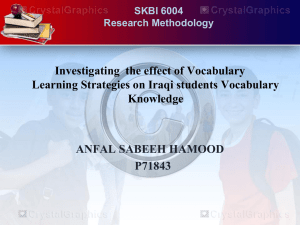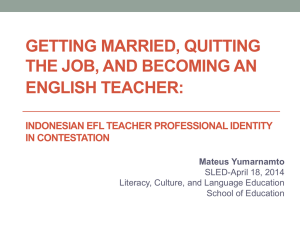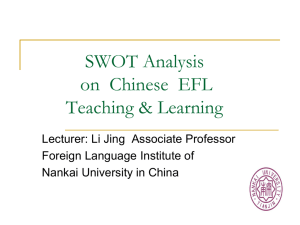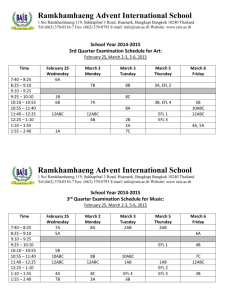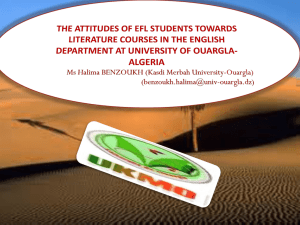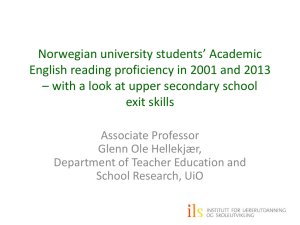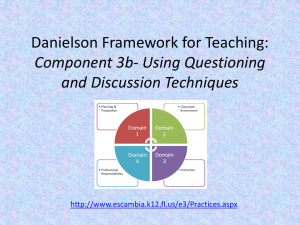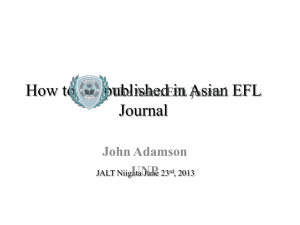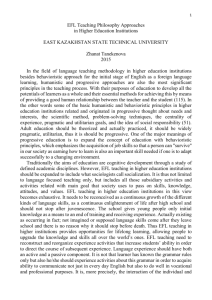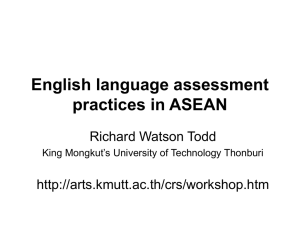Questioning
advertisement
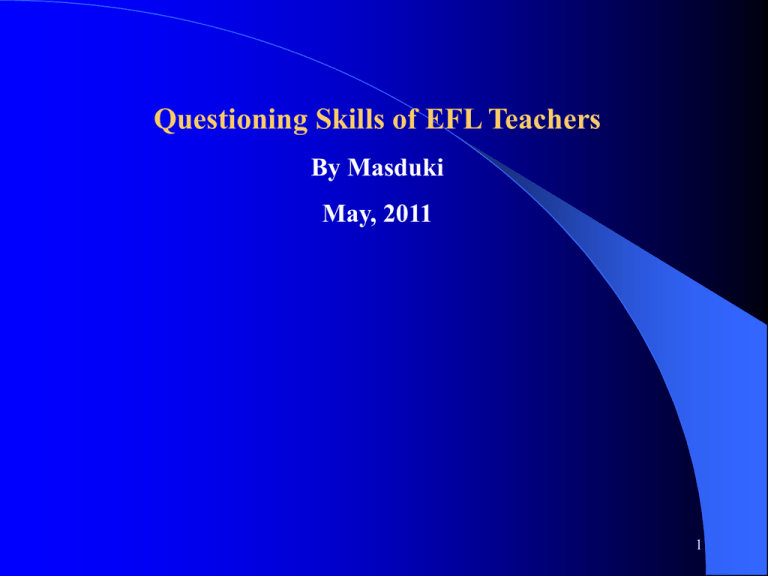
Questioning Skills of EFL Teachers By Masduki May, 2011 1 Ice-breaking Background: Character Shift is here in the “Song of Questions” Song I: “Kowe bocah ngendi Le?” “Kula lare ndesa” “Kowe arep nyangdi Le?” “Badhe dateng kuta” “Kathik nggawa arit Le?” “Damel mbacok Landa” “Yen Landane mati Le?” “Indonesia merdeka” Song II “Kowe bocah ngendi Le?” “Kula lare ndesa” “Kowe arep nyangdi Le?” “Badhe dateng kuta” “Kathik nggawa arit Le?” “Damel pados arta” “Yen wus duwe duit Le?” “Damel sinau maca” Song III “Kowe bocah ngendi Le?” “Aku bocah ndesa” “Kowe arep nyangdi Le?” “Arep menyang kuta” “Kathik nggawa arit Le?” “Kanggo mbacok kanca” “Yen kancamu mati Le?” “Sepedahe tak gawa” The Real Background: Shift of teaching paradigm should be here accordingly! PP 19/2005 A Shift in the Teaching of Reading: A Traditional Approach To Reading • Reading is a matter of simply extracting information from the text • The text is full of meanings • The meanings can be poured straight into the readers’ mind 7 The (relatively) new approaches to reading Goodman (1995): Psycholinguistic Model Eskey (1998): Interactive Model Anderson (2000): Schema Theory 9 Psycholinguistic View of Reading Reading is not a linear process. Readers sample texts, make and test hypotheses and predictions about what they are reading (based on their background knowledge) How? A reader makes use of his organ information processing for: Recognition Initiation (Goodman, 1995) Prediction Confirmation Correction Termination 10 The Interactive Approach Suggests Reading is a more complex process. 2. Reading is “a kind of dialog” between the reader and the text. 1. 3. “Interaction” perspectives. has been handled form two 4. Interaction between the reader and the text. 5. Interaction between the lower and higher levels of reading process. 11 What can we learn from the models: 1. Teachers of reading comprehension are supposed to activate necessary and relevant schemata to assist the students. 2. The reader’s prior background of the content facilitates his/her processing the text. 3. Fluent reading results from the simultaneous interaction between the higher and the lower level skills of reading. 12 Lower level skills are known as identification skills: Recognizing words and sentences necessary for decoding and extracting explicit information Higher level skills require more cognitive efforts: Reading between the lines to find the implicit information Reading beyond the lines to understand the writer’s point of view and making interpretation. Fluent reading occurs only when lower and higher levels operate together. 13 What happens in EFL reading classes ? EFL Reading Classes : Reading is a complex process. Students have not yet mastered the medium for successful reading activities (Sadtono, 2005). AN EFL TEACHING PROBLEM 14 EFL Reading Classes continued Many studies are conducted focusing on learners: e.g. investigating the strategy used by learners to comprehend a text (Retno, 2004). Common evidence (Rubin. 1994; Yuliati, 1999; Emeksiz. 2003) shows that reading interactions in EFL classes may not always occur among the learners themselves. Learners may need someone who will promote interaction and comprehension. 15 Who ? THE TEACHER Why? 1. To initiate and sustain interaction in the classroom is the teacher’s responsibility. 2. The teacher’s performances is as important as the learner for a complemented interactive process. Teacher’s Intervention Is Required 16 How/What Intervention ? In EFL Reading Classes : Teachers make use of different tools to initiate interaction in the classroom. The most commonly used tool is ASKING QUESTIONS (Long and Sato. 1983; Johnson. 1990; Ellis. 1994). 17 Why Questions? Through asking questions, teachers help learners: Develop lower and higher cognitive process Use their background knowledge to interact with the text and to build comprehension The teacher is a professional question maker (Gall, 1970) To know how to question is to know how to teach To question well is to teach well Good questions are vital to good teaching (Averbach, 1983) 18 Questioning is the most: Influential single teaching act. Valuable of all teaching devices. The Greatest medium of instruction (Hyman. 1989). IT IS ALMOST IMPPOSSIBLE TO CONCEIVE OF TEACHING WITHOUT ASKING QUESTIONS 19 This Study : A particular concern with the use of questions by non-native English teachers, focusing on: The Types of Questions How to make teacher questions effective in understanding helping students reach (how teachers should make use of questions teaching) effectively in 20 The Research Problems : What are the types of questions posed by EFL teachers in RC courses? How do EFL teachers make effective questions in RC courses? 21 Findings: 4.1 The Types of Questions Posed by the EFL Teachers in RC Courses 4.1 Display Questions: Requesting the students to display their knowledge known by the teacher 4.2 Referential Asking for information which is not known by the teacher Closed With only a single correct answer Open With multiple correct answers 22 4.2 Strategies Employed by EFL Teachers to Make Effective Questions Translation (Code Switching) Repetition Pausing (wait-time) Probing o Focusing on Subordinate Category o Focusing on exemplification Rephrasing o Using clues that describe the attribute of the expected answer o Comparing or contrasting the expected answer to something o Giving an alternative/choice 23 Conclusions: The Types of Teacher Questions: The range of questions as observed falls into two categories: Display and Referential Display > Referential The observed teachers : Activate lower level skill of reading Call for surface level meaning 24 Conclusions…………………………….. continued Response Types of questions (e.g Wh-Question > Yes/No Question) Open question types trigger more complex utterances than closed questions types ---------------------------------------- 25 Conclusion…………………………..continued No rigid separation of question types took place during the reading No single type of question turned out to be the most effective Combination of display and referential Effective -------------- 26 The strategies to make effective questions Translation Repetition Pausing Probing +Modif. Rephrasing +Modif. Effective questioning strategies (Helping /facilitating students to reach the intended responses in comprehending a reading text) 27 ………………………….continued Effective questioning strategy in one reading class (L-1) Not always effective in another class (L-2/EFL) Language proficiency of teachers and learners Level of questions Purpose of questioning Contributing factors 28 ……………………….continued No rigid separation of strategy took place during the reading No single type of strategy turned out to be the most effective Combination of more than one strategy Effective (for specific shared purpose) 29 Possible Combinations Translation Clarity Rephrasing Wait-time Distribution Repetition Sequence Rephrasing (Structuring) Probing Translation Clarity Repetition Rephrasing Wait-time Sequence Probing Rephrasing Referring to the findings on question types and strategies Aspects of Effective Teacher questions Linguistic Clarity Conciseness Non-Linguistic Form Sequence Wait time Distribution 35 Suggestions for Teachers and the LC Teachers’ Intervention in ESP is required. The intervention is directed to the use effective questions and questioning strategies ---------------------------University Students High order thinking Exploration of concept and Ideas High level questions (referential) 36 Suggestion………………………………………………………continued Teaching Asking Question Adopt questioning strategies increasing students’ involvement ! Support a special training for questioning skill ! 37 For other researchers 1. 2. 3. Question Important tool in language classroom Strategy Modification Make students get involved A quantitative study to see the effect of different types of questions on the student responses in other language skill is interesting The students’ psychological effect upon receiving questions Investigation involving more subjects with different background 38 39 Research Method The study is intended to explore: The types and the strategies that make teacher question effective in reading comprehension courses. Qualitative Approach to enable descriptions and in-depth analyses 40 The Design A Case Study It is a research design in which the researcher typically observes the characteristics of an individual or a group of individuals. The observation is to probe deeply and analyze intensively multifarious phenomena: One exceptional case/individual actor (exemplary teachers) was chosen A specific setting was examined (reading Comprehension course) A particular event was observed (asking questions) 41 Research Subjects Purpose: To describe some possible aspects that make EFL Teacher Questions Effective. The subjects required: English teachers of reading comprehension course 42 What Kind of Teacher? Those who are believed: To be representative of everything observed (Questioning The act to be observed) To provide maximum insight and understanding Exemplary Teachers (Good Teachers) Needed! How to select? “Selecting a sample of participants/subjects who is perceived to be special, relevant, and to have superior performance, and thus, deserve to be the exemplary sample” 43 Selection of the research subject Conducted in UMM; 46 teachers were selected Selection process: Already existing mechanism: Board of Academic Quality Assurance (BKMA) Student’s opinion Result: 2 exemplary teachers found 44 Data and Data Sources Utterances of Reading Comprehension Teachers: Data Teacher questions and Students’ opinion (statements) Teachers and Students as a Source of data Teacher questions and statements (Soft Data) Transcriptions of teacher questions (Hard Data) 45 Instruments The Researcher Human instrument to respond, adapt, emphasize, expand, process, clarify, and explore during data collection and analysis Field-notes To write everything the researcher experiences and thinks during the data collection Video and Audio-tape recorder: To record the events in the field 46 Data Collection The Researcher: Observing the classroom process Recording verbal interaction (questions generated by teachers) and stop recording until researcher finds the point of data saturation Interviewing the subjects Transcribing Coding the data 47 Data Analysis Data Reduction Data Display Conclusion Drawing Verification 48 Data Collection Field notes Transcription Data Coding Data Reduction Data Display Temporary Conclusion (one semester?) No Yes Final Conclusion Types of EFL Teacher Questions Effective EFL Questioning Strategies 49 Research Stages Developing Research Design A Case study Preliminary Study: Finding Research Focus Observing Feasible Subjects (Exemplary Teacher) Actual Study Sources: Reading Classes Responses to Interview DATA Instrument: Researcher Video&Tape Recorder Field notes Collection: Non Participant Interview Analysis Finding Report Writing 50
